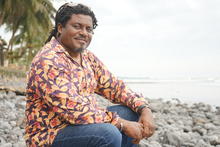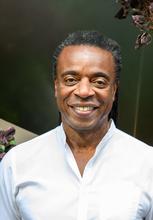
This is the first in a series of roundtable discussions between contemporary artists working in Africa and the United States funded by the Henry Luce Foundation. Work by both Cole and Youmbi is featured prominently in Homecoming, the Stanley’s inaugural exhibition. Both Youmbi—a Cameroonian artist who lives and works in Douala—and Cole—an American sculptor, printer, and perceptual engineer—make works that respond to and build upon African art-making traditions while interrogating the colonial practices of art museums in the Western world.
If you are not able to attend in person, join us on the event live stream: https://uiowa.zoom.us/j/91459120969
Born in the Central African Republic in 1973, Hervé Youmbi lives and works in Douala. A passion for drawing and painting led him to attend the Institut de Formation Artistique of Mbalmayo, Cameroon, from 1993 to 1996. There he discovered his affinity for installation art. It was during a brief time at the École supérieure des arts décoratifs de Strasbourg (from 2010 to 2011) that he produced his first videos. As a result, his artistic process began to focus to a greater extent on both multimedia installation and work involving urban public spaces.
Youmbi often integrates traditional Cameroonian sculpture techniques within his installations, performances, and videos. This allows him to juxtapose indigenous African art traditions with contemporary global art conventions and to destabilize what is regarded as traditional versus that which is contemporary. Youmbi’s series “Visages des Masques/Faces of Masks” transgresses these established categories in several ways. By inserting mask forms that diverge from Western stereotypes of African art for this region of Cameroon into “traditional” Bamileke ritual performances, he embodies them with efficacy and authenticity.
Notions of circulation run through Youmbi’s work. He challenges the status of art in traditional settings by placing sculptural works that have been ritually enacted in “the field” in Cameroon in art galleries and museums and making it possible for them to return to the “field” afterward if their new owners desire.
Hervé Youmbi is a founding member of Cercle Kapsiki, a collective group of five visual artists and scenographers from Douala founded in 1998 that also provides a cultural exchange space, the K Factory. This space serves as a resource center for young artists seeking to effect radical change in a country whose government shows no interest in arts education.
Willie Cole is a contemporary American sculptor, printer, and conceptual artist. His work combines references to everyday consumer objects and appropriation from African and African American imagery.
Cole is well-known for his Dada and Surrealist readymades, in which ordinary domestic and used objects—such as irons, ironing boards, hair dryers, bicycle parts, wooden matches, lawn jockeys, and other discarded appliances and hardware—are assembled and transformed. His long-running Mother and Child series of assemblages uses high-heeled shoes to convey the thematic figures. The forms created by the well-worn shoes recall traditional African sculpture.
The steam iron is another long-standing motif in Cole’s work. Using a variety of media, he imprints scorch marks made by an iron, showing their wide-ranging decorative potential while also referencing his African American heritage, using the marks to suggest the transport and branding of slaves, the domestic role of Black women, Ghanaian cloth design, and Yoruba gods.
Through the repetitive use of single objects in multiples, Cole’s assembled sculptures acquire a transcending and renewed metaphorical meaning. In addition to their Dada and Surrealist ties, the assemblages relate to various other art historical traditions such as Nouveau Réalisme (as in the work of artist Arman), postmodern eclecticism (Funk Art), and Pop Art.
Cole grew up in Newark, New Jersey. He attended the Boston University College of Fine Arts, received his Bachelor of Fine Arts from the School of Visual Arts in New York in 1976, and continued his studies at the Art Students League of New York from 1976 to 1979.

